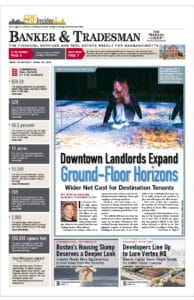
Big changes underway in Greater Boston’s commercial real estate and finance sectors are creating a range of new opportunities to build wealth for minority and women investors and entrepreneurs, local executives say. iStock photo illustration
Boston leaders were eager to use the NAACP national convention’s spotlight this weekend to dispel an image among Black America’s movers and shakers of the city as a largely white place where racism still lingers.
Big changes underway in the region’s commercial real estate sector help back that up, local executives say.
“Movement is happening in Massachusetts,” said Redgate managing principal Daryl Settles said. In the 1990s, “I could go a whole day working downtown without seeing another Black or brown person. People are now in roles where they are empowered to speak up.”
First, “the majority” of major players in the local commercial real estate industry are actively seeking Black and Brown talent, Settles said, and rapidly diversifying firms in an industry that still holds a reputation as lily-white thanks to generations of white executives recruiting largely from personal and family networks.
But just as powerful have been work to open access to capital and business development opportunities to developers of color.
Scaffolding Grows as Firms Grow
Starting with Massport’s minority equity and workshare participation requirements for development teams working on the thousand-room Omni Seaport Hotel, increasing numbers of requests for proposal covering publicly owned land have adopted what’s become known locally as the “Massport Model.” It’s allowed increasing numbers of women- and minority-owned real estate and construction firms to get more and more experience while building relationships with established businesses, local executives say.
The five-year-old Builders of Color Coalition is also providing a growing scaffolding – networking venues, a jobs board and training opportunities – that help even more entrepreneurs and firms grow. The coalition’s latest effort, called “Meet the Banks” aims to break down barriers to financing by centralizing in-depth information about several local banks’ commercial lending products in one portal for the coalition’s roughly 650 Greater Boston-focused members, said Executive Director Colleen Fonseca.
“We’re creating relationships, especially when it comes to banks that are serious about diversifying [the borrowers in] their commercial real estate portfolios,” she said. “Social capital is sometimes required to receive funding. If a financial institution has a relationship with you before you request the funding, it sometimes makes it more likely you’ll get funding…Not every banker comes from the communities that our developers come from.”
The 14 member lenders – the highest profile names include Cambridge Savings Bank, Eastern Bank, DCU, First Boston Capital Partners, Needham Bank, Northmarq and MassDevelopment – also plan to support coalition members in “becoming bigger employers and building a more inclusive economy,” Fonseca said.
“We’re trying to grow our business with folks who need extra capital. Whether they’re white or brown or Black doesn’t matter, but we think that this effort speaks to our values,” said David Grossman, president of Meet the Banks participant First Boston Capital Partners.
Financial Industry Innovates
The wealth being created by Boston developments is also starting to trickle – or at least, opportunities are being created for it to trickle – into a more diverse set of pockets.
Accordia Partners co-managing principal Kirk Sykes, Redgate’s Settles and fellow Black developer Richard Taylor launched the Boston Real Estate Inclusion Fund in 2022 using an unusual hybrid structure that lets smaller investors take part in some of the city’s big developments.
By partnering with Basis Investment Group, Sykes said, the fund can piggyback on Basis’ status as an SEC-registered investment advisor and the capital it manages on behalf of institutional investors. This lets BRIEF’s investors – it markets itself to minority and women investors – with as little as $50,000 to put down take part in large projects, instead of having to assemble the net worth over $1 million or annual income above $200,000 to qualify as an investor in non-public offerings like real estate funds.
“We can create a new middle class that’s more equitable and reflective of our majority minority city. You can’t send a kid to college on a lower rent” from living in affordable housing, said Sykes, who’s also promised to contribute $10 million to the Massachusetts Affordable Housing Alliance’s STASH first-generation homebuyer down payment assistance program from the profits of Accordia’s Dorchester Bay City development. “In simple terms there are only two ways to close the racial wealth gap. Better paying jobs and creating equity.”
The biggest BRIEF-funded project likely to break ground soon is Related Beal’s 22 Drydock in the Seaport District. The 319,000-square-foot project has secured city approvals and has been pre-leased to Vertex Pharmaceuticals. And Sykes hopes that Boston’s diverse economy and its resultant relative stability can create more money-making opportunities for diverse small investors around the country.
Even the traditionally slow-moving finance industry is seeing change, with initiatives like Eastern Bank’s new Equity Alliance for Business and the Foundation for Business Equity, a prominent CDFI that spun out of Eastern late last year. Other innovators, like Boston Impact Initiative CEO Betty Francisco, are trying to help diverse entrepreneurs break out of traditional equity financing models that might otherwise bleed wealth from a new company when it’s only just getting off the ground.
Economy Holds Efforts Back
Still, Boston has a way to go before it can match the progress made in some major Northern cities, said Brookings Institution scholar Tracy Hadden Loh.
“Yes, what’s happening in Boston is good and is more than what many other cities are doing. But is it the most aggressive and innovative work to create inclusion in commercial real estate? No,” she said.
The kinds of efforts underway in the region have to be sustained over 20 years to be able to match leaders like Chicago, a city where “the development teams and the company owners and the people with equity stakes controlling these projects reflect the hustle and culture of the whole city,” Hadden Loh said.

James Sanna
And for now, as the threat of a recession hangs over the national economy, wealth-building in communities of color is being forced into a holding pattern as the Federal Reserve’s campaign of interest rate hikes filters down through the economy, causing some of the greatest pain in communities of color along the way.
“Our pipeline is really strong but the number of businesses looking for capital is lower. We’re seeing more businesses focusing on building up cash management, building up customers,” said Francisco. “Businesses are coming to us because the businesses doing business with them, if they’re a B2B, are being squeezed on their finance terms – they’re being paid later, so they need lines of credit to float them.”
Still, key players are optimistic, pointing to the social and professional connections a new generation of diverse local power players in real estate and finance have built up with each other.
“The only thing that’s holding us back now is the economy,” Redgate’s Settles said.




 |
| 

